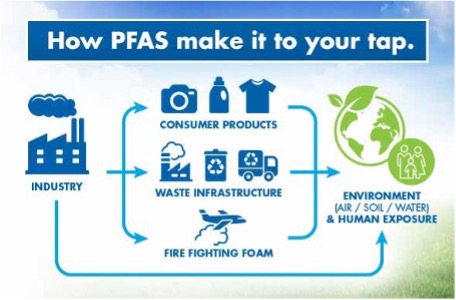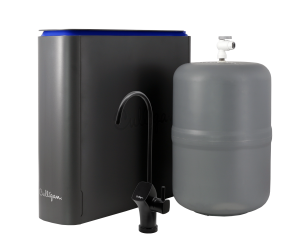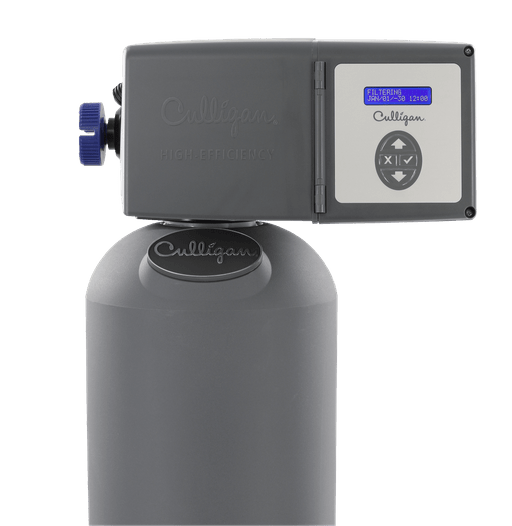Does Your Indio, California Water Have PFAS Contamination?
The problem with PFAS and similar contaminants is that, until recently, few people knew or understood them. Compounding this issue, PFAS have become nearly ubiquitous in our environment. These “Forever Chemicals” in urban areas near Indio are more likely to be in household water than many other regions of the nation, according to a study done by ScienceDirect.
Researches estimated that at least 45% of drinking water across the nation could contain one or more of the chemicals. In Southern California alone, an ABC7 analysis showed PFAS was found in more than 200 water systems, servicing more than 18 million people at some point over the last 10 years.
Since 2019, the California State Water Resources Control Board has been proactively researching and testing for PFAS. Throughout the year, the set response levels for drinking water were maintained at 10 parts per trillion for PFOA and 40 parts per trillion for PFOS. The Division of Drinking Water also recently set response levels for two more PFAS variants: Perfluorobutane sulfonic acid (PFBS) and Perfluorohexane sulfonic acid (PFHxS). In 2022, the Board introduced a new PFAS Monitoring Order, which mandates monitoring of these four PFAS substances and an additional 21 related chemicals, starting in the early part of 2023.
PFAS Forever Chemicals EPA Regulations
On April 10, 2024, the United States government introduced its first-ever national, legally enforceable drinking water standard to protect citizens from PFAS forever chemicals. The new rules to regulate six types of PFAS chemicals were developed based on feedback from the public and stakeholders, with over 120,000 comments considered. The EPA believes that these rules will protect about 100 million people from PFAS exposure over time, prevent thousands of deaths, and reduce tens of thousands of serious illnesses related to PFAS.
The EPA has also announced that it will be offering substantial funding, including $1 billion from the Bipartisan Infrastructure Law, to help test and treat PFAS in not only public water systems but address contamination in private wells as well.
The new regulations set limits known as ‘Maximum Contaminant Levels or MCLs’ for individual PFAS like PFOA, PFOS, PFHxS, PFNA, and HFPO-DA, as well as a combined limit for mixtures of PFHxS, PFNA, HFPO-DA, and PFBS. While these regulations will help to protect from 6 PFAS, there are over 15,000 PFAS chemicals.
The new regulations state areas exceeding the new standards of PFAS contamination must take action to reduce PFAS in their drinking water within 5 years.
How to Remove PFAS From Your Indio Water
There is no way for you prevent PFAS contamination in the environment, but you can make sure the water you’re drinking is PFAS free. If there is good news regarding PFAS water contamination, it’s that they can be treated and removed from water with the right filtration. For example, several methods, like carbon filtration, ion exchange, and reverse osmosis water treatment effectively remove PFAS from water.
Removing PFAS from water is a complex process that requires advanced filtration techniques. Culligan offers several products that can help address PFAS contamination. Here are a few options:
Reverse Osmosis (RO) Systems: Culligan’s RO systems are highly effective in removing PFAS from water. These systems use a semipermeable membrane to filter out contaminants, including PFAS. The RO process can remove up to 99% of PFAS, providing you with clean and safe drinking water.
Whole House Water Filtration Systems: Culligan’s whole house filtration systems can remove various contaminants, including PFAS, from all the water in your home. These systems provide comprehensive filtration, ensuring that every tap in your house delivers clean and safe water.
It’s important to note that the effectiveness of these filtration systems may vary depending on the specific type and concentration of PFAS in your water. To determine the best solution for your specific needs, I recommend reaching out to a Culligan Water Expert who can assess your situation and provide personalized recommendations. They will be able to guide you through the process and help you choose the most suitable product for your home.
Can Pitcher Filters Remove PFAS Forever Chemicals?
Pitcher filters, like those commonly used for home water filtration, may vary in their ability to remove PFAS compounds, often referred to as “forever chemicals” due to their persistence in the environment. Some pitcher filters are designed with activated carbon filters that can help reduce certain contaminants, including PFAS, from drinking water. However, the effectiveness of pitcher filters against PFAS can vary based on the specific brand and model.
If you are concerned about PFAS contamination and want to ensure the efficacy of a pitcher filter in removing these chemicals, it’s advisable to choose a filter that explicitly states it can remove PFAS, such as Culligan’s RO system or whole home water filtration system. Always refer to the manufacturer’s specifications and certifications to determine the filter’s effectiveness against PFAS and other contaminants.
Is My Indio Water Contaminated With PFAS?
When it comes to PFAS-contaminated water, the situation can be particularly relevant to residents of Indio California, especially those serviced by Culligan. Certain areas are more susceptible to elevated levels of PFAS due to historical usage of these chemicals in various industrial and commercial activities.
Living near specific sites, such as airports or firefighter training facilities, could put residents at a higher risk of encountering water with elevated PFAS concentrations. These sites historically utilized PFAS-containing foams for firefighting exercises and emergency response drills, which could have seeped into the ground and eventually reached the water supply. As such, individuals residing near these locations might be concerned about the levels of PFAS in their tap water.
Manufacturing centers in Indio are another area of focus when it comes to PFAS contamination. With its economic diversity, the city may have a history of manufacturing activities related to carpet production, food packaging, and various consumer goods. PFAS were commonly used in these processes due to their unique chemical properties. Over time, these chemicals might have entered the local water sources, potentially leading to higher concentrations in certain areas. This situation is particularly important to Culligan of Indio, as a water treatment and purification company, to address potential PFAS-related concerns in their service areas.
For residents of Indio, understanding the actual levels of PFAS in their water is crucial. Culligan, with its expertise in water treatment and purification, is well-positioned to provide essential information and potential solutions. Regular water testing and analysis can help determine the extent of PFAS contamination in various neighborhoods.

Further Explanation On What “Forever Chemicals” Are
PFAS, commonly known as ‘Forever Chemicals,’ water contamination impacts residents in many places across the United States, including the Denver area. The problem with PFAS and similar contaminants is that, until recently, few people knew or understood them. Compounding this issue, PFAS have become nearly ubiquitous in our environment.
It started in the early 1940s, when water and heat-resistant chemicals containing per- and polyfluoroalkyl substances were engineered to help create non-stick products (Teflon), fire retardants, and other common consumer goods. What wasn’t understood at the time, however, was that Teflon and other products using PFAS wouldn’t naturally decay in nature–or the human body.
Known as bioaccumulation, this chemical characteristic means any amount absorbed in our bodies – through eating or drinking – stays in our bodies. Since we have no way of removing or disposing of these chemicals, they’ve earned the ominous nickname, ‘forever chemicals.’ As a result, most PFAS have been phased out of use in this country. But they remain prevalent in the environment, and this includes our water supply.
What About PFOA? Where Are They Found?
PFOA, the most notable substance of the PFAS family, was found to be a part of the manufacturing process of Teflon. The EPA sued DuPont in 2005 for failing to report a health risk to both humans and the environment. The company paid a $10.25 million settlement.
Because of PFOA and PFAS strong molecular structure, they take much longer to break down naturally than other organic chemicals.

Until 2002, PFOA were integral in producing goods which qualities repel dirt, grease, water and stains.
These contaminants can be found in the manufacturing process of a variety of products, including non-stick cookware, carpet-care liquids, treated apparel, upholstery or textiles, sealants, dental floss, floor wax and non-woven medical garments. Though PFTE non-stick cookware was proven to have PFOA levels, a recent study found levels that ranged from undetectable to 4.3 parts per billion, and it is not currently considered a major pathway for PFOA.
Just last year, United Nations experts recommended banning PFOA globally at the Stockholm Convention on Persistent Organic Pollutants. Will the United States follow suit based on recent outbreaks in California and Michigan.
Problems with PFOA
According to a study from 2002-2005, people who lived in the PFOA-contaminated area around DuPont’s Washington Works facility were found to have higher levels of PFOA in their blood from drinking water. People that drank more tap water, ate locally grown fruits and vegetables, or ate local meat, were all associated with having higher PFOA levels.
Residents who used carbon filter systems had lower PFOA levels.” Studies have found that using carbon-activated filters can reduce PFOA by up to 60%.
Popular Brands Contaminated with PFAS Forever Chemicals
According to the Agency for Toxic Substances and Disease Registry, PFAS, known for their oil and water resistance, non-stick, and fire-resistant qualities, are commonly added to various everyday products used by most Americans such as the following:
- Cosmetics
- Food packaging: take out containers, food wrappers
- Non-stick pans (Teflon)
- Carpets, rugs, furniture textiles, window treatments, car seats
- Stain and waterproof clothing
- Outdoor gear
- Umbrellas
- Dental Floss
- Microwaveable popcorn bags
- Firefighting foam and personal protective gear
- And more.
Simply Orange Juice PFAS Contamination
A class action lawsuit alleges Simply Tropical and Simply Orange beverages have been promoted as “All Natural” and made with “all-natural ingredients.” Nevertheless, the lawsuit contends that lab tests conducted on Simply Tropical contradict these claims, revealing the presence of PFAS, artificial chemicals that are not natural.
PFAS Contamination In Lululemon
An analysis by Toxic-Free Future tested 60 items from various categories, discovering that 35 products, mostly leggings and yoga pants, had fluorine levels exceeding 100 parts per million, a strong PFAS indicator. Among the brands tested were Lululemon and Old Navy. Of these, three-quarters contained banned long-chain PFAS compounds. Notably, 28% of the tested products contained PFAS, with 34 out of 47 items with water-resistance claims showing PFAS presence. An additional investigation also found PFAS in popular sportswear brands, raising questions about long-term exposure risks associated with PFAS-coated clothing.
Forever Chemicals in Menstrual Products
The Thinx underwear brand was involved in a lawsuit alleging their products contained PFAS after the marketed their products as a safe, sustainable product, free of harmful chemicals. The period underwear company has settled a lawsuit regarding allegations of inadequate product effectiveness and misleading advertising.
PFAS In Sparkling Water
According to Green Matters, Consumer Reports detailed the levels of PFAS found in many popular carbonated water brands contain. Topo Chico, owned by Coca-Cola Co., was an extreme outlier containing 9.76 parts per trillion. Most brands tested were only slightly above 1 part per trillion, with Poland Spring at 1.66, Canada Dry at 1.24, LaCroix at 1.16 and Perrier at 1.1. As for non-carbonated water, Deer Park tested at 1.21 parts per trillion.

Recommendations by the EPA
The EPA holds the responsibility of overseeing the regulation of drinking water standards. While PFAS regulation in drinking water has not yet been established by the EPA, they have outlined suggested Maximum Contaminant Levels of 4 parts per trillion (ppt) for PFOA and PFOS. The EPA is anticipated to unveil the final regulations for PFOA and PFOS by the conclusion of 2023.
To put this into perspective, comprehending the scale of a part per trillion is essential. Picture one ppt as a single droplet of water dispersed across 20 vast Olympic-sized swimming pools or one second in 32,000 years.
Solutions
Suggested Products

The Aquasential® Smart Reverse Osmosis Water Filter (RO)
- 7 stages of filtration and 12 filter options
- Certified for reduction of 58 contaminants
- 2-in-1 sediment and carbon filter screens out sediment and particles
- Can alert you and your dealer when service or filter replacements are needed

Aquasential™ Smart High Efficiency Whole House Water Filters
Reduce sediments in your water and contaminants that cause your water to appear, taste, and smell unpleasant. Your system can also lessen the taste and odor of chlorine, and prevent pipe damage and staining from low pH water. Additional customizations include:
- Culligan® Filtr-Cleer® Water Filters – Reduces Sediment Problems
- Culligan® Cullar® Water Filters – Reduces Taste and Odor Problems
- Culligan® Cullneu Water Filters – Reduces Acid Problems

Facebook